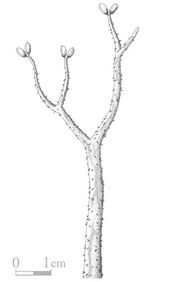Yunia
Topic: Biology
 From HandWiki - Reading time: 3 min
From HandWiki - Reading time: 3 min
| Yunia | |
|---|---|

| |
| Reconstruction of Yunia dichotoma according to its description. | |
| Scientific classification | |
| Kingdom: | Plantae |
| Clade: | Streptophyta |
| Clade: | Embryophytes |
| Clade: | Polysporangiophytes |
| Clade: | Tracheophytes |
| Clade: | Lycophytes |
| Plesion: | †Zosterophylls (?) |
| Genus: | †Yunia S.G.Hao & C.B.Beck (1991)[1] |
| Type species | |
| Yunia dichotoma S.G.Hao & C.B.Beck (1991)
| |
| Species | |
| |
Yunia is a genus of extinct vascular plants from the Early Devonian (Pragian or Siegenian stage, around 411 to 408 million years ago). It was first described from the Posongchong Formation of Yunnan, China. The leafless plant consisted of spiny stems, some 2 to 5 cm wide, which branched dichotomously at wide angles in a cruciate arrangement. Each stem contained vascular tissue with one or two strands of protoxylem. The spore-forming organs (sporangia) were elongated and borne on short stalks. The spores had a relatively smooth sculptural pattern and were trilete (i.e. each spore has three lines on it resulting from its formation in a tetrahedral set of four spores).[1][2]
In 2004, Crane et al. published a simplified cladogram for the polysporangiophytes in which Yunia is basal to the lycophytes (clubmosses and relatives).[3] It had previously been placed in the "trimerophytes"[1] (a group now thought to be paraphyletic), which were considered to have given rise to all the other vascular plants except the lycophytes.[4]
Hao and Xue in 2013 considered the genus as a questionable zosterophyll.[5]
References
- ↑ 1.0 1.1 1.2 Hao, Shou-Gang; Beck, Charles B. (1991), "Yunia dichotoma, a Lower Devonian plant from Yunnan, China", Review of Palaeobotany and Palynology 68 (3–4): 181–195, doi:10.1016/0034-6667(91)90022-U, https://deepblue.lib.umich.edu/bitstream/2027.42/29227/1/0000282.pdf
- ↑ Taylor, T.N.; Taylor, E.L.; Krings, M. (2009), Paleobotany : The Biology and Evolution of Fossil Plants (2nd ed.), Amsterdam; Boston: Academic Press, ISBN 978-0-12-373972-8, p. 262
- ↑ Crane, P.R.; Herendeen, P.; Friis, E.M. (2004), "Fossils and plant phylogeny", American Journal of Botany 91 (10): 1683–99, doi:10.3732/ajb.91.10.1683, PMID 21652317
- ↑ Taylor, Taylor & Krings 2009, p. 259ff.
- ↑ Hao, Shougang; Xue, Jinzhuang (2013), The early Devonian Posongchong flora of Yunnan: a contribution to an understanding of the evolution and early diversification of vascular plants, Beijing: Science Press, p. 52, ISBN 978-7-03-036616-0, https://www.researchgate.net/publication/269875285, retrieved 2019-10-25
External links
Wikidata ☰ Q8061285 entry
 |
 KSF
KSF